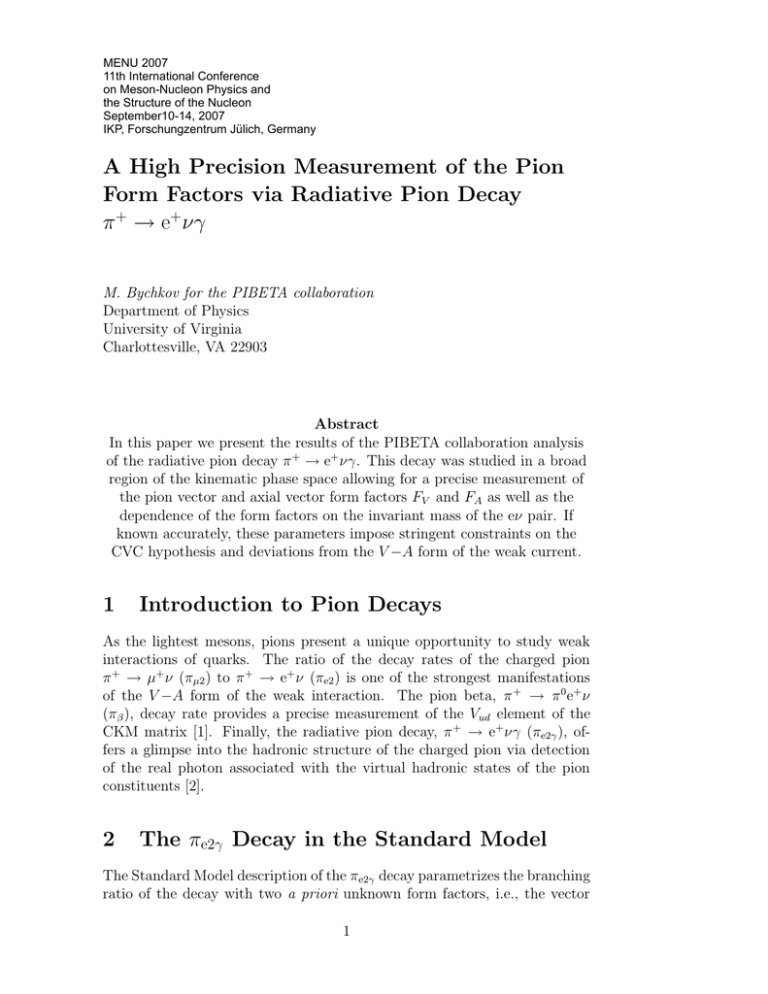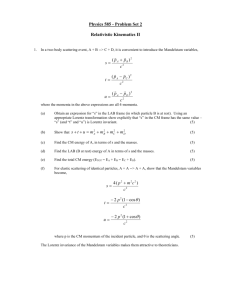MENU 2007 11th International Conference on Meson-Nucleon Physics and
advertisement

MENU 2007 11th International Conference on Meson-Nucleon Physics and the Structure of the Nucleon September10-14, 2007 IKP, Forschungzentrum Jülich, Germany A High Precision Measurement of the Pion Form Factors via Radiative Pion Decay π + → e+νγ M. Bychkov for the PIBETA collaboration Department of Physics University of Virginia Charlottesville, VA 22903 Abstract In this paper we present the results of the PIBETA collaboration analysis of the radiative pion decay π + → e+ νγ. This decay was studied in a broad region of the kinematic phase space allowing for a precise measurement of the pion vector and axial vector form factors FV and FA as well as the dependence of the form factors on the invariant mass of the eν pair. If known accurately, these parameters impose stringent constraints on the CVC hypothesis and deviations from the V −A form of the weak current. 1 Introduction to Pion Decays As the lightest mesons, pions present a unique opportunity to study weak interactions of quarks. The ratio of the decay rates of the charged pion π + → µ+ ν (πµ2 ) to π + → e+ ν (πe2 ) is one of the strongest manifestations of the V −A form of the weak interaction. The pion beta, π + → π 0 e+ ν (πβ ), decay rate provides a precise measurement of the Vud element of the CKM matrix [1]. Finally, the radiative pion decay, π + → e+ νγ (πe2γ ), offers a glimpse into the hadronic structure of the charged pion via detection of the real photon associated with the virtual hadronic states of the pion constituents [2]. 2 The πe2γ Decay in the Standard Model The Standard Model description of the πe2γ decay parametrizes the branching ratio of the decay with two a priori unknown form factors, i.e., the vector 1 M. Bychkov Pion Form Factors via π + → e+ νγ decay form factor FV and axial-vector form factor FA , such that µ ¶2 the n £ ¤ dBπe2γ m2π α (FV + FA )2 SD+ + (FV − FA )2 SD− = Bπe2 IB + dx dy 2π 2fπ me ¶ µ ¤o mπ £ + − (FV + FA ) Sint + (FV − FA ) Sint + r.c. , (1) + fπ where α is the fine structure constant, mπ and me are pion and positron masses, and fπ = 130.7 MeV is the pion decay constant. The IB (x, y), ± SD± (x, y), and Sint (x, y) (IB–SD interference) terms depend on the kinematic variables x = 2Eγ /mπ and y = 2Ee /mπ where Ee and Eγ are the particle’s energies, and “r.c.” stands for radiative corrections. The conserved vector current (CVC) hypothesis [3] relates FV to the π 0 lifetime, yielding FV = 0.0259(9) [5]. The value of the FA is model dependent and chiral symmetry calculations (see Ref. [4] and references therein) give a value for FA in the range 0.010–0.014. In the lowest order of the chiral expansion the ratio of the form factors is related to the pion electric polarizability αE = (α/8π 2 mπ Fπ2 ) × FA /FV . 3 The πe2γ Decay in Experiment Most of the earlier experimental measurements of the πe2γ decay were conducted in the high-Eγ , high-Ee regions of the phase space and relied on the precise knowledge of the vector form factor from the neutral pion life time, thus looking for the ratio of the FA /FV . The world average prior to the PIBETA publications was FA = (116 ± 16) × 10−4 [5]. Our measurements were performed at the πE1 beam line at the Paul Scherrer Institute (PSI), Villigen, Switzerland, using a stopped π + beam and the PIBETA detector [6]. For this analysis we used 2.0 × 1013 stopped π + ’s and the decay products accumulated in three overlapping regions of the phase space defined as: A: Ee+ , Eγ > 50 MeV; B: Ee+ > 10 MeV and Eγ > 50 MeV; C: Ee+ > 50 MeV and Eγ > 10 MeV, with relative angle θe+ γ > 40◦ for all regions. In our experiment we have observed positron and photon pairs from the πe2γ decay in overdetermined kinematics which allowed for a strong suppression of the copious positron background coming from the decays of the muons. The time difference distribution between the positron and the photon arrival to the CsI calorimeter defined our peak signal in the ∆t = |te − tγ | < 5 ns region. The sample of the accidental background taken from the sidebands of the same distribution was subtracted from the events in the peak. 2 Pion Form Factors via π + → e+ νγ decay M. Bychkov In parallel to the πe2γ events, we have recorded a large sample of the nonradiative πe2 decays. In order to reduce the systematic uncertainty associated with the absolute number of pions stopped in the target, we have used these decays for the absolute normalization of the radiative pion decay branching ratio. The πe2 absolute branching ratio is a very well known quantity both theoretically and experimentally [5,7,8]. Both types of events were corrected by the detector acceptance. The acceptance calculations were provided by a GEANT3 based rendition of the PIBETA detector. The quality of the data and the simulation is demonstrated in Fig. 1. Number of events π → eνγ Simulation 2000 • Measurement 1500 A 1000 B 500 0 0 0.2 0.4 0.6 0.8 2 λ ≡ (2Ee/mπ)sin (Θeγ/2) 1 1.2 Figure 1: Background-subtracted π + → e+ νγ distribution of the kinematic variable λ ≡ (2Ee /mπ ) sin2 (θeγ /2) for regions B and A. In order to extract the value of the form factors, experimental and theoretical branching ratios of the πe2γ decay were combined into the χ2 function exp (i) the (i) X (Bπe2γ (FA , F V, a) − Bπe2γ (FA , FV , a))2 , χ = σi2 (FA , FV , a) i=A,B,C 2 (2) where σi2 are the combined uncertainties for each region, and the parameter a signifies the dependence of the form factor on the invariant mass of the eν pair q 2 such that FV (q 2 ) = FV (0)(1 + a · q 2 ) and FA (q 2 ) = FA (0). The χ2 function was minimized as function of the free parameters FA , FV , and a. 3 M. Bychkov 4 Pion Form Factors via π + → e+ νγ decay Results In this analysis we have reconstructed 35,948 ± 194 (0.54%) events in region A, 16,246 ± 331 (2.0%) events in region B and 13,263 ± 161 (1.2%) events in region C, where numbers in parentheses are fractional statistical uncertainties. The simplest analysis of our data is in the form of a fit with fixed values of FV = 259 × 10−4 and a = 0.041 [9],leaving only one free parameter, FA . Under these conditions our data provide FA = (119 ± 1) × 10−4 . This result represents a sixteenfold improvement in precision over the pre-PIBETA world average. Alternatively, we released all three parameters FA , FV , and a simultaneously, and obtained FA = (117±17)×10−4 , FV = (258±17)×10−4 , and a = 0.095 ± 0.058. These results (i) agree very well with the predictions of the CVC hypothesis for the charged pion form factors, (ii) represent a fourteenfold improvement in the precision of the vector form factor FV , and (iii) provide the first ever measurement of the charged pion form factor slope parameter a. Finally, fixing FV = 0.0259, a = 0.041 (standard model values), and FA = 0.0119 (our best-fit value), we varied the contribution of the putative tensor coupling form factor, FT , as defined in Ref. [10]. The optimal fit yields FT = (−0.6 ± 2.8) × 10−4 , or −5.2 × 10−4 < FT < 4.0 × 10−4 at the 90% confidence limit. References [1] D. Počanić et. al., PRL 93, 181803-1 (2004). [2] E. Frlež et. al., PRL 93, 181804-1 (2004). [3] V. G. Vaks and B. L. Ioffe, NC 10, 342 (1958). [4] J. Bijnens and P. Talavera, NPB 489, 387 (1997). [5] S. Eidelman et. al., Phys. Lett. B 592, 1 (2004). [6] E. Frlež and others, NIM 526, 300 (2004). [7] W. J. Marciano and A. Sirlin, PRL 71, 3629 (1993). [8] V. Ciriglano and I. Rosell, hep-ph/0707.3439v1, (2007). [9] J. Portoles and V. Mateu”, hep-ph/0706.1039v2, (2007). [10] M. V. Chizhov, hep-ph/0402105, (2004). 4


